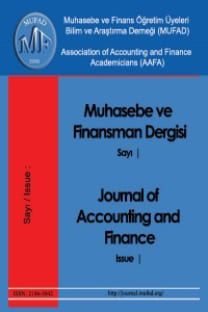Cash flow statement that was reported according to Turkish accounting standards and its analysis
Cash flow statement that was reported according to Turkish accounting standards and its analysis
___
- Akdoğan, Nalan - Tenker, Nejat (2007), Finansal Tablolar Analizi, 11. Baskı, Gazi Kitabevi, Ankara.
- Altman, E. (1968), Financial Ratios, Discriminant Analysis and the Prediction of Corporate Bankruptcy, Journal of Finance, September, pp. 589-609. (Aktaran: Nenide, 2010)
- Beaver, William H. (1966), Financial Ratios as Predictors of Failure, Journal of Accounting Research, Vol. 4, Empirical Research in Accounting: Selected, pp. 71-111. (Aktaran: Nenide, 2010)
- Bruwer, B.W.S. - Hamman, W.D. (2005), Cash Flow Patterns in Listed South African Industrial Companies, Meditari Accountancy Research, Vol. 13, No. 1, pp. 1-17.
- Deakin, E. (1972), A Discriminant Analysis of Predictors of Business Failure, Journal of Accounting Research, Spring, pp. 167-179. (Aktaran: Nenide, 2010)
- Gücenme, Ümit - Poroy Arsoy, Aylin (2006), Muhasebe Standartlarındaki Sınıflandırılmış Nakit Akım Tablosu Formatı ile Finansal Performansın Ölçülmesi, Muhasebe ve Finansman Dergisi, Sayı 30, ss. 66-74.
- Gup, B.E. - Samson, W.D. - Dugan, M.T. - Kim, M.J. - Jittrapanun, T. (1993), An Analysis of Patterns from the Statement of Cash Flows, Financial Practice and Education, Fall, pp. 73-79.
- Ibarra, Venus C. (2009), Cash Flow Ratios: Tools For Financial Analysis, Journal of International Business Research, Vol. 8, Special Issue 1, pp. 91-107.
- Jooste, Leonie (2006), Cash Flow Ratios as a Yardstick for Evaluating Financial Performance in African Businesses, Managerial Finance, Vol. 32, No. 7, pp. 569-576.
- Mills, J.R. - Yamamura, J.H. (1998), The Power of Cash Flow Ratios, Journal of Accountancy, October, pp. 53-61.
- Mulford, C.W. Comiskey, E. E. (1996), Financial Warnings, John Wiley, New York. (Aktaran: Bruwer ve Hamman, 2005)
- Nenide, B. - Pricer, R.W. - Camp, S.M. (2010), The Use of Financial Ratios for Research: Problems Associated with and Recommendations for Using Large Database, http://www.fintel.us , (Ocak, 2010)
- Özerhan (Akbulut), Yıldız - Yanık, Serap (2010), TMS/TFRS: Açıklamalı ve Örnek Uygulamalı Türkiye Muhasebe Standartları, Türkiye Finansal Raporlama Standartları, TÜRMOB Yayınları 377, Ankara.
- Plewa, F.J. - Friedlob, G.T. (2002), New Ways to Analyze Cash Flow, The National Public Accountant, Feb, pp. 25-43, http://www.entrepreneur.com .
- Sylvestre, J. - Urbancic, F.R. (1994), Effective Methods for Cash Flow Analysis, Healthcare Financial Management, Vol. 48, No.7, ABI/INFORM Global ,pp. 64-70.
- Yılmaz, Hüseyin (1999), İşletmelerin Finansal Yönetiminde Nakit Akış Rasyo Analizi, D.E.Ü.İ.İ.B.F. Dergisi, Cilt 14, Sayı 1, ss. 185-198.
- Kamuyu Aydınlatma Platformu, http://www.kap.gov.tr/yay/ek/index.aspx, (Nisan, 2010). Türkiye Muhasebe Standartları Kurulu, http://www.tmsk.org.tr , (Nisan, 2010).
- ISSN: 2146-3042
- Yayın Aralığı: 4
- Başlangıç: 2005
- Yayıncı: Muhasebe ve Finansman Öğretim Üyeleri Derneği (MUFAD)
Cash flow statement that was reported according to Turkish accounting standards and its analysis
Kurumsal kaynak planlama sistemlerinin muhasebe süreçlerine etkisine yönelik İMKB'de bir araştırma
Türkiye'de 1988-2008 dönemindeki firma birleşmeleri,birleşme dalgaları ve genel tablo
Bankalarda vadeye kadar elde tutulacak menkul kıymet işlemleri ve etkin faiz yöntemi
Hüseyin Ali KUTLU, N. Savaş DEMİRCİ
Kobi'lerde ufrs ve basel II düzenlemelerinin farkındalığının araştırılması: Doğu marmara örneği
Attitudes of accounting professions and businesses about ethics: Turkey case
